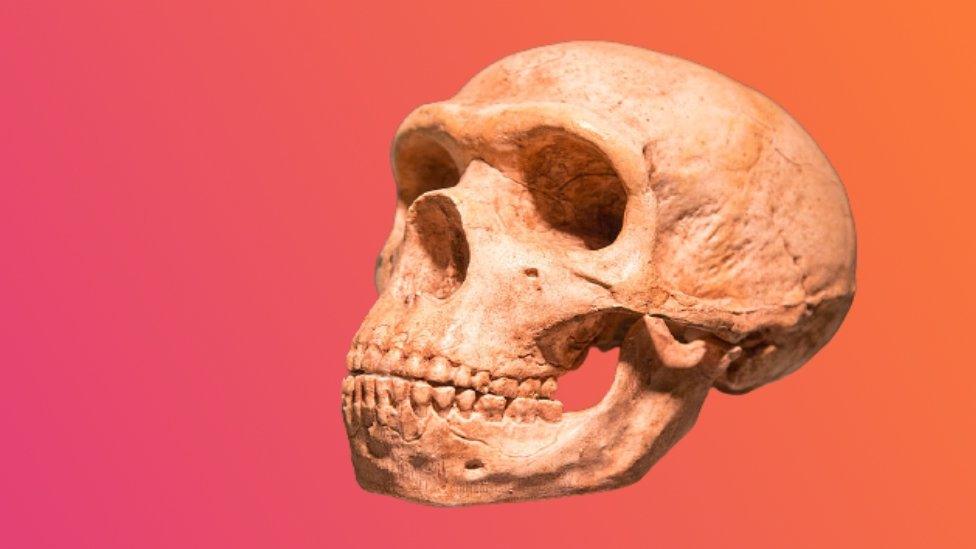How climate changed size of our bodies and brains
- Published
- comments

A skull of Homo Neanderthalensis in the archaeology museum of Jerez de la Frontera, Spain
Scientists have discovered that climate change has changed the size of human bodies and brains.
The study, by scientists at the University of Cambridge in the UK and the University of Tubigen in Germany, suggests that the average body size has shifted over the last million years and is strongly linked to temperature.
Colder, harsher climates caused the evolution of larger body sizes, while warmer climates led to smaller bodies.
While brain size has also changed dramatically, it did not evolve at the same time that body size did, they also discovered.
What else do we know?
Skulls from left to right: Neanderthal, 5,.000 years ago, ~1750 cm³, Homo sapiens, 32,000 years ago, ~1570 cm³, Middle Pleistocene Homo, 430,000 years ago, ~1100 cm³
The study gathered measurements of body and brain size for more than 300 fossils from the genus Homo found across the world.
The team then identified the climate experienced by each fossil when it was a living human. Then they combined this data with a reconstruction of the world's regional climates over the last million years.
Our species, Homo sapiens, emerged around 300,000 years ago in Africa.
Experts believe this cave art in the Amazon could have been made by migrants from Siberia who crossed into the Americas nearly 17,000 years ago, during the ice age
But the genus Homo has existed for much longer, and includes the Neanderthals and other extinct, related species such as Homo habilis and Homo erectus.
A defining trait of the evolution of our genus is a trend of increasing body and brain size.
Compared to earlier species such as Homo habilis, humans are 50% heavier and our brains are three times larger.
...climate - particularly temperature - has been the main driver of changes in body size for the past million years.
Human fossils illustrating the variation in brain (skulls) and body size (thigh bones) during the Pleistocene.
Professor Andrea Manica, a researcher in the University of Cambridge's department of zoology, who led the study, said: "We can see from people living today that those in warmer climates tend to be smaller, and those living in colder climates tend to be bigger."
He explained that this influence of climate on our bodies has "been at work for the last million years."
Researchers say the human body is still adapting to different temperatures, with on average larger-bodied people living in colder climates today.
What about our brains?
Oldupai Gorge in Tanzania, East Africa is one of the most important sites in the world where evidence has been found of early human species from Homo Habilis who lived here 1.9 million years ago through to the most recent inhabitants Homo Sapiens 17,000 years ago.
The researchers also found that brain size tended to be larger when Homo was living in habitats with less vegetation, like open grasslands, but also in ecologically more stable areas.
The results suggest those living in these habitats hunted large animals as food - a complex task that might have driven the evolution of larger brains.
The environment has a much greater influence on our body size than our brain size
Dr Manuel Will at the University of Tubingen, Germany, first author of the study, said: "We found that different factors determine brain size and body size - they're not under the same evolutionary pressures."
He added: "There is an indirect environmental influence on brain size in more stable and open areas: the amount of nutrients gained from the environment had to be sufficient to allow for the maintenance and growth of our large and particularly energy-demanding brains."
The research also indicates that non-environmental factors were more important for driving larger brains than climate.
These included the added challenges of increasingly complex social lives, more diverse diets, and more sophisticated technology.
Brain size in our species appears to have been shrinking since the beginning of the Holocene (around 11,650 years ago).
Researchers suggest that the increasing dependence on technology may cause brains to shrink even more over the next few thousand years.‚Äã
- Published7 July 2021
